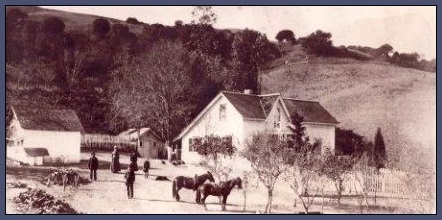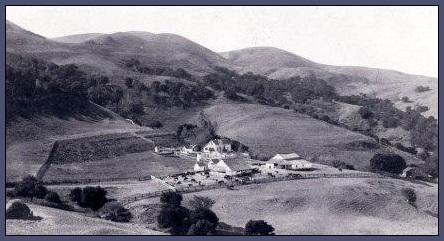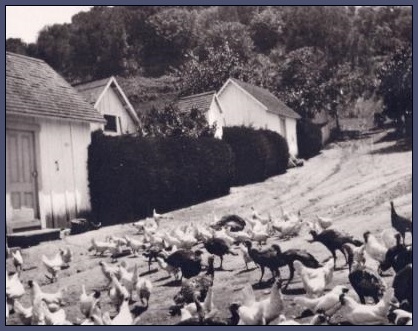History of Norris Canyon

Early History
For thousands of years the Ohlone/Costanoan and Seunen Indians lived in the San Ramon Valley and by 1770, their population was estimated to be approximately 10,000. Over the next 50 years, disease from European explorers and settlers brought the population to less than 2,000 and the California Gold Rush reduced their numbers even further.
In the late 18th century, the area was colonized by the Spanish Empire, who established several missions to secure their claim to the land, teach natives Christianity and the Spanish way of life. In 1797, Mission San Jose, which is located in Fremont, was established and the San Ramon Valley was used as grazing land. In 1822, following Mexico's independence from Spain, the mission lands were granted to private citizens as ranchos.
Don Jose Maria Amador
Jose Amador was born in San Francisco in 1794 and his father, Pedro, had been on the first Spanish overland expedition to California. Jose Maria was a soldier, Indian fighter and the administrator for Mission San Jose. In 1834, Jose Amador received a grant of more than 20,000 acres and named it Rancho San Ramon. He had very large herds of cattle, horses, pigs and sheep. He had large orchards, vineyards and grew melons, corn and wheat.
In 1850, California became part of the United States and land granted to Spanish soldiers was not well recognized by the U.S. courts. Jose Amador sold all his property, at very low prices and moved to a relative's home in Watsonville, where he died, destitute, at age 89.
Leo and Mary Norris
In 1846, Leo and Mary Norris traveled west from Missouri with 50 wagon trains of settlers. The group they were with decided to take a new route through the Sierra Nevada Mountains, but the Norris' parted company and went a different way. The other group is better known as the Donner Party. Six months after leaving Missouri, the Norris' arrived in San Francisco.
In 1850, Leo Norris purchased 4,451 acres from Jose Amador. This was the first property purchased by an American in the Valley and was called the Norris Rancho. It became the namesake for Norris Canyon Road.
Greenleaf Clay and David Hutchings
After the American Revolution, Congress was interested in encouraging people to settle in the West. In 1785, the Public Land Survey was enacted, where the Federal Government issued land to soldiers who had fought in the American Revolution, War of 1812, on the Union side of the Civil War or in the war with Mexico.
Greenleaf Clay and David Hutchings were privates with the Massachusetts Militia during the War of 1812 and acquired property in the Norris Canyon area, probably between 1850 and 1867. This property would eventually become part of Norris Canyon Estates.
The Wiedemann Family
Christian Wiedemann sailed from Germany, arriving in San Francisco around 1855. He was a carpenter by trade and worked at a dairy, in what is now known as Daly City. This is where he learned a general knowledge of cattle.
Most of the flatland in the San Ramon Valley had been purchased by the Norris, Harlan, Glass and other families, leaving only land in the hills available, which was good for raising cattle, but limited for growing crops.
In November of 1867, Christian Wiedemann purchased 160 acres of land from Greenleaf Clay, under the Scrip Warrant Act of 1856. At the same time, Wiedemann's friend, Carl Schwerin, purchased 160 acres of land from David Hutchings' widow, Hannah Hutchings. In March of 1870, Carl sold his 160 acres to Christian.
Christian built a Victorian farmhouse around 1868, which had scalloped trim and a small balcony. It was built with ancient redwood taken from the Oakland area and is still occupied by the family today.

House built by Christian Wiedemann. Photo circa 1888
Roxanne and Randy Lindsay have lived in the original house since 1974. Roxanne is Christian Wiedemann's great granddaughter.

Wiedemann Ranch in 1888
Wiedemann Ranch in 2011
Christian raised horses, cattle, turkeys and pigs and grew hay, barley fruits and nuts. Wood cut to clear the land was sold as firewood. By 1903, Christian's property grew to 480 acres and was worth $8.00 per acre. The tallest hill, just west of Norris Canyon Estates, is named Wiedemann Hill and has an elevation of 1844 feet.
Rock walls are a common sight on the Wiedemann property, as well as many other ranches and farms across the country. After the Gold Rush and the completion of the Transcontinental Railroad in 1869, there was a large group of unemployed Chinese laborers. Ranchers and farmers hired them to clear their property so they could use horse drawn plows and mowers for crops such as wheat or hay. Some rock walls are on the property lines and some are not. The two photos above are on Wiedemann Hill.
Christian died in 1914, at age 80 and being a widow, left the ranch to be divided equally among his four children. His two sons, Fred and Henry, worked in the cattle and hay business, purchasing additional property in San Ramon. His two daughters, Maria and Emma lived in the house until the early 1960's. After their deaths, the house was leased to the Lenz family between 1962 and 1974. In 1974, Roxanne Wiedemann Lindsay and her husband, Randy Lindsay moved in and still live their today.

Roxanne's great aunts, Maria and Emma, raised a considerable number of chickens and turkeys for sale.
Fred and Henry Wiedemann continued to expand, but sometime in the 1920's, their partnership dissolved and Fred became the sole manager of Wiedemann Ranch. By 1962 the Ranch had expanded to about 4600 acres.
In 1963, Fred Wiedemann died and left ownership of the ranch divided equally between his two children, Howard and Ann Marie. Ann Marie leased her part of the ranch to Howard, who continued to run the business with his son, Jeff.
Howard died in 1982, shortly after being named "Cattleman of the Year." Jeff, his wife Nancy and their sons, Clayton and Christian, run the business today.
According to a current NCE resident, the Wiedemann and Lindsay families are very nice people.
Jeff Wiedemann and HCV Pacific Partners
In the early 1980's, the City of San Ramon incorporated and several ranchers in the area wanted to be part of the General Plan for the City. Norris Canyon Estates, a 300 acre project, was presented to the San Ramon City Council, but through the efforts of a group known as "Save Our Hills", the Council voted against the project. Jeff Wiedemann went to the County planners and the same project was approved.
By 1990, Jeff Wiedemann and HCV Pacific partners were rough grading the property and installing water tanks.
Freitas Family
260 Lyndhurst Place is a five acre parcel that starts at the top of Lyndhurst and goes south to the water tanks. This was part of a larger ranch owned by the Freitas family and when the ranch was divided among the family, Susan Christensen received this parcel. The Freitas' have the ranches that are directly across from the Gatehouse and to the left, going up Norris Canyon Road.
In 2006, Susan Christensen attended several homeowner meetings and made a presentation about dividing the lot into one acre parcels and building five houses. This was strongly opposed by several residents, who lived at the top of Lyndhurst, as they did not want the traffic from five more homes. The request to modify the lots was voted down by the HOA. It was later divided into two lots, but as of 2011, nothing has been done to the property.
Toll Brothers Inc.
In 1997, Jeff Wiedemann and HCV Pacific Partners sold 200 acres of property to Toll Brothers, who planned on building 362 homes. Toll Brothers created three areas: The Meadows, the Highlands and the Ridge.
Roubion
In 2005, Toll Brothers sold 73 lots to Western Pacific, who later sold them to IHP Capital Partners Inc. These lots are situated in the highest area of Norris Canyon Estates and were named after a small commune in the French Alps.
IHP Capital Partners Inc.
IHP Capital Partners Inc. worked with WL Homes, dba John Laing Homes, for development of the 73 lots in the Roubion subdivision. After building and selling several homes, John Laing Homes filed for bankruptcy in 2009.
WL Homes / John Laing Homes
John Laing Homes began in England in 1848. In 1998 John Laing merged it's U.S. operations with Watt Residential Partners and became WL Holmes, dba John Laing Homes. In 2006, the operation was purchased by Emaar Properties from Dubai, one the world's largest builders. In 2009, WL Homes and John Laing Homes filed for bankruptcy. The bankruptcy court ordered several unfinished homes sold, along with 18 vacant lots, which Toll Brothers purchased.
2011
Norris Canyon Estates consists of 343 acres, with hundreds of acres of private land and East Bay Regional Park's property surrounding it.
Toll Brothers, who has 58 lots, continues to build and sell homes. IHP has 41 lots in the Roubion subdivision and is working with SummerHill Homes to complete the project.
Neighboring Ranches
On Norris Canyon Road, across from the Wentwood Gate, is the Thomas Ranch. Built in 1884 by Joseph Rose, the 370 acre ranch produced cash crops and raised cattle. In 1904, Joseph Rose died and his daughter, Isabelle, married Louis Thomas. By 1910, Joseph's wife, Isabella and several other family members, moved to a house on "C" Street in Hayward.
Louis and Isabelle Thomas moved into the ranch house, along with Isabelle's brother, Manuel Rose. Over the next 74 years, several generations of the Thomas family occupied the ranch, including Lawrence and Marjorie (Thomas) Zaharis.
The current residents are Mark and Debbie (Zaharis) Chewning, who have lived there since 1984. Mark is from Portland, Oregon and Debbie is the great granddaughter to Louis Thomas. They have worked hard to restore and preserve the original ranch, which is very challenging, considering the house, barns and out-buildings are almost 130 years old.